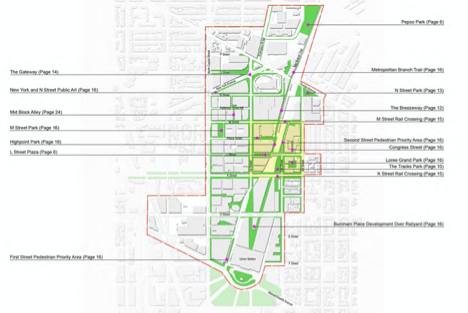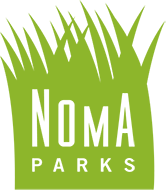
Public Engagement History
NoMA PARKS FRAMEWORK
For many years, the NoMa BID and NoMa Parks Foundation have worked to identify ways to overcome the omission of parks in the original planning for NoMa. The NoMa BID, building on the DC Office of Planning’s Small Area Plan for NoMa, the NoMa Vision and Development Plan of 2006, invested significant resources in creating, with strong community engagement and consensus, visionary park planning frameworks for NoMa:
- American Planning Association Charrette (2011)
- NoMa Public Realm Design Plan (2012)
- Public Realm Design Plan Community Meeting Summary (2012)
These frameworks were developed in community open houses and stakeholder meetings to discuss the future of public space throughout the NoMa neighborhood starting in 2011. Community priorities expressed by participants are listed below.
In 2012, the NoMa Public Realm Design Plan, was published and identified a system of signature open space opportunities and streetscape enhancements consistent with community priorities that would connect and support the NoMa neighborhood.
Projects suggested in the NoMa Public Realm Design Plan took a unique approach to the idea of “parks”, separately considering: (1) the diverse array of needs that communities want their parks to address and (2) knitting together public and privately-owned spaces in NoMa. Without this public-private approach as its centerpiece, the cause of parks in NoMa would have been doomed.
The NoMa Public Realm Design Plan became the foundational document for the public-private partnership between the District Government and the NoMa Parks Foundation as codified in the NoMa Parks Grant Authorization Act.
The community highly valued the following as qualities and characteristics for NoMa parks:
- “Connectivity” and “Corridors” emerged as strong themes
- Parks should be multi-use
- Daily use (employees in area and residents)
- Special events (concerts, movie nights, festivals)
- Farmers’ market
- Celebrate existing character
- Seating
- Vegetation
- Playgrounds
- Appropriate ratio of permeable to impermeable surface
- Public art
- Exercise and fitness
- Connections to Metropolitan Branch Trail
- Beautification
- Play nice with streets
- Incorporate the “vibe of the railroad”
- Creating a commons with a unique identity
- Spaces should be multi-generational
- Spaces should delight all of the senses
- Parks should not segregate activities but bring people together
- Destination maps
- Kiosks
SELECT OTHER NPF COMMUNITY ENGAGEMENT ACTIVITIES:
- FL/NY Intersection Project (“Virtual Circle”) Community Conversations, Surveys and DDOT Public Meetings – 2019 through 2021
- “Swampoodle II” Community Conversation – 2021
- Swampoodle Park Community Conversations -2016 through 2017
- Alethia Tanner Park Community Conversations – 2016 through 2017
- Underpass Installation Project Competition Community Conversation and Survey-2014
- Community Park Naming Processes
- Alethia Tanner Park – 2018
- Swampoodle Park – 2017
- “Swampoodle II” – Current
- Ongoing involvement with ANC’s 6C and 5E and other parks-oriented community groups
SELECT OTHER NOMA BID ENGAGEMENT ACTIVITIES:
* Only community outreach addressing park and public space design are included
- Metropolitan Branch Trail Safety and Access Study – 2015
- NoMa Streetscape Guidelines – 2017
NoMa Parks Foundation © 2024

